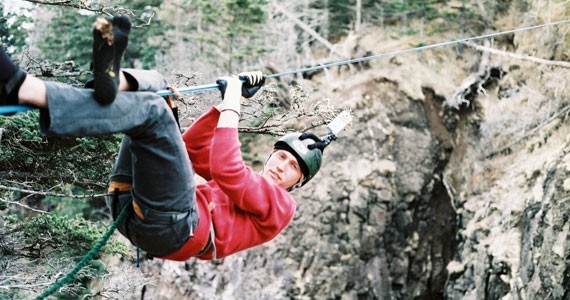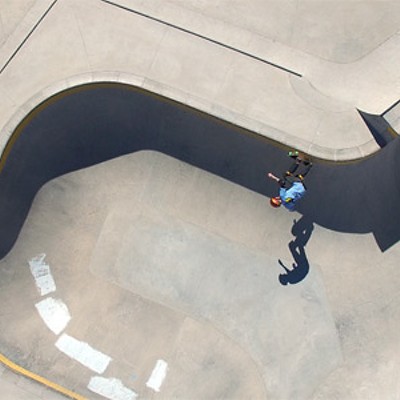Cait Anthony is dangling 250 feet in the air, crying. Her arms, legs and torso are bruised and aching. Ocean waves are breaking on rocks in the gorge beneath her. Her boyfriend is yelling at her to stand up.
Cait, 23, is a slackliner. She's hanging from her safety harness, strung to a slackline that stretches between two opposing cliffs, 150 feet apart. A slackline is like a tightrope, but made of bouncy nylon.
Slacklining is popular among college kids on sunny days in the park. Cait is one of several Haligonians taking it to new heights.
For hours, she has been trying to stand on the line. Each time, before she finds her footing, she falls.
She gets back on.
She plants her right foot on the line, which is stiff as a metre stick, and lets her left foot dangle beneath her. Every time she makes a movement---a slip, a bounce, a grab---the entire line twitches from end to end and rattles the trees.
Her body trembles, and her gaze drops into the crevasse.
"Right," she thinks. "I'm supposed to try and stand up and walk?"
Cait has to relax and clear her mind, lift her left foot, put it on the line and stand up--- all at once. As soon as she tries, her fears go wild. "What if my foot catches on the line?" she thinks. "What if I go flying? What if my safety line snaps me in the eye again? What if the line breaks?'"
If she's not focused, she will fall.
With 25 storeys beneath her, Cait throws her left foot onto the line and tries to stand. As she extends her knee, the line makes a snap-rattle. It slingshots out from under her and sends her head-first toward the ocean.
Cait falls past the slackline, and the thought enters her mind: "Shouldn't my safety line have caught me by now? Why am I going further?" She grunts. "There it is."
Slacklining was invented by bored mountain climbers in the '70s, who improvised lines out of climbing equipment. It remained an obscure climbers' sport for three decades.
Around 2006, slacklining burst into pop culture via the internet. Over the next few years, videos went viral as slackliners set new records, like the first frontflip and the world's highest highline (at 3,200 feet up). In 2009, Mountain Equipment Co-op started selling slackline kits. Over the next three years, sales increased 20-fold.
Slackliners attribute the sport's success to its accessibility. Anyone can buy a kit for less than $100, and be taking steps by the end of the day. That simple setup always remains mentally and physically challenging, even for pros. But many slackliners choose to push themselves in creative ways.
Some locals rig lines 30 feet up in tree canopies, between piers over the harbour or over the railroad gorge in the south end. Others trespass onto construction sites at night and rig lines up between building skeletons.
Around the world, slackliners are pushing themselves by walking on higher lines, looser lines, over water and lines held taut by crowds of people. They skydive off of lines, backflip on lines, do yoga on lines, slide down inclined lines, unicycle on lines, do skateboard tricks on lines, teach their dogs to slackline and slackline between moving vehicles. Despite their fanaticism, they're not in it for the thrill. They're in it for the calm.
To rig the slackline over the gorge, Cait and her friends find solid anchors. A slackline can topple a weak anchor like a small boulder or a pillar, and a bad mechanism can fail. Either event can maim or kill.
They set up two lines, attached to large trees. The second line is a backup, and they tape it to the main line.
Once Cait is on, there's 500 to 1,000 pounds of force pulling on the trees at each end. The nylon rope can hold 10 times that much force before breaking; enough to hang an elephant. But that weight gets multiplied when you start bouncing. Cait can bring the line close to its breaking point when she falls and her safety line jerks her to a stop. There's enough force at play to do damage.
Last summer, Cait's ratchet broke while she was tensioning a slackline. The unleashed force stripped the metal teeth from the cog and fired them into her leg. Another local once tensioned a long line so tight that he snapped it. Where it broke, the nylon was hot and melted.
When Cait falls on a slackline, it smacks her like a cane. When she loses her balance, it fires her off like a slingshot. "It's my stress release," she says. "It is so much mental stamina and concentration that everything else just has to leave your mind for you to do it. It's meditation. Moving meditation."
When Cait starts on a line, her tension and anxiety push her right off. She has to let go off all of that, balance, and take a step. If her mind is clear, she stays balanced and takes another step.
If she thinks about anything, she will fall. From setting up the line to falling off, her mind has to be calm, clear and focused.
Five months pass after Cait's defeat at the gorge before she and her friends go back to try again.
Within minutes on the line, she's ready. Crouched on her right foot, she lifts her left foot onto the line and stands up.
"Holy shit," she thinks. "I'm standing up. I can actually do this."
She holds it for a moment, and falls.
Sam Littlefair-Wallace is a freelancer who concussed himself on his first slacklining attempt.












